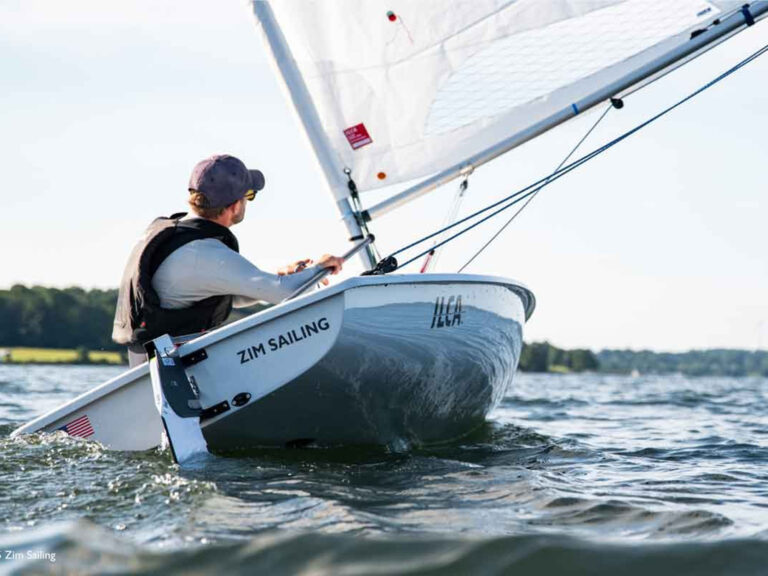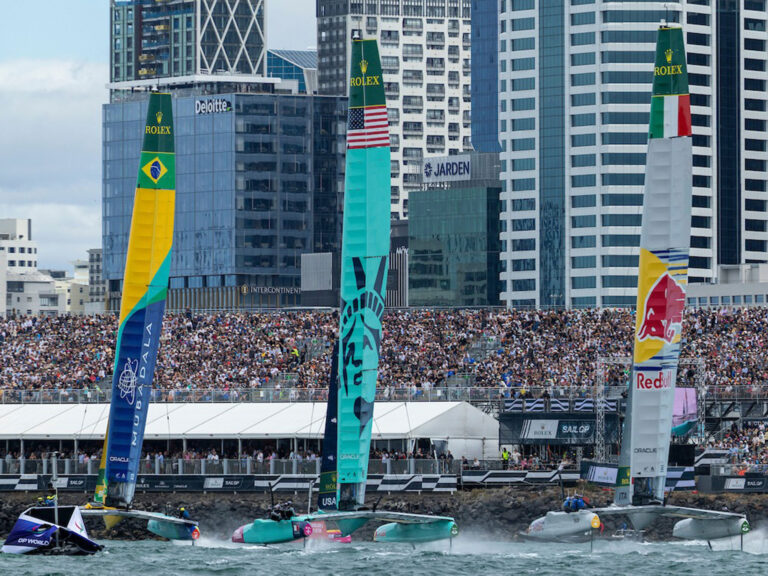
RulesSt
Joseph Just races J/24s off the west side of Manhattan near the mouth of the Hudson River, and he recently described a leeward mark pile-up that occurred in one of the Manhattan Sailing Club’s summer evening races. This rounding situation we’re about to explore gives Rule 18, which covers mark roundings, a strenuous workout. I’ll describe the situation and then answer each of Mr. Just’s questions in turn. When you encounter one of his questions, I suggest you put down the magazine, open your rulebook, and try to answer the question yourself before reading my answer.Here are the facts provided by Mr. Just. A fleet of boats was broad reaching on port tack toward a leeward mark that they were required to leave to port. The next leg was a beat to windward. The wind was light and there was a strong crosscurrent perpendicular to the wind, pushing the boats away from the mark as they approached it. As a result, boats approached the mark a bit high of the rhumb line to counter the current’s effect. As the boats closed in on the mark, their crews began to move about while dousing spinnakers. The jostling of the boats, and the dousing of the spinnakers, caused their speeds to drop, and boats behind, with spinnakers still drawing, gained on the boats ahead.Al was in the lead. As shown in the diagram, when Al reached the two-length zone, Beth had a slight inside overlap to windward on him, and Chuck had a slight inside overlap to windward on Beth. Beth’s overlap on Al, and Chuck’s overlap on Beth continued throughout the rounding. These three lost speed as they neared the mark, and Dina overtook them.Dina was clear astern of Chuck when Al reached the zone, and she was still clear astern of Chuck when Beth reached it. However, she did establish a small inside overlap to windward on Chuck before he reached the zone.Which boats were required to give room and to whom?To answer this question it’s important to keep in mind that the rules of Part 2 apply to pairs of boats. Therefore, we must apply the rules between Al and Beth, Al and Chuck, Beth and Chuck, Al and Dina, etc. Hang on. Here we go.Al and Beth were overlapped when Al reached the zone. Rule 18.2(a) required Al to give Beth room. Rule 18.2(b) required him to continue to give her room until both of them had left the mark astern, and to do so even if the overlap between them had been broken before or during the rounding. Rule 11 also applied andrequired Beth to keep clear of Al.The definition Clear Astern and Clear Ahead; Overlap states that two boats “overlap when a boat between them overlaps both.” When Al reached the zone, Al and Beth were overlapped, Beth and Chuck were overlapped, and Beth was between Al and Chuck. Therefore, when Al reached the zone, he and Chuck were overlapped and so Rules 18.2(a) and (b) applied between them just as they did between Al and Beth. Beth and Chuck were overlapped when Beth reached the zone. Therefore, Rules 18.2(a) and (b) applied between Beth and Chuck, just as they did between Al and Beth and between Al and Chuck.What about Dina? When Al reached the zone Dina was clear astern of Chuck. Because neither Beth nor Chuck, who were each between Al and Dina, overlapped both Al and Dina, Al and Dina were not overlapped at that critical moment. So Rule 18.2(c) applied between Al and Dina, and Dina was not entitled to room from Al. If I had been Al’s tactician, at the moment when I judged our boat had reached the zone, I would have hailed loud and clear, “Dina, you get no room from us!” Beth also reached the zone before Dina overlapped Chuck. Therefore, Beth also should have hailed to inform Dina that she would not get room.Let’s sum up what we’ve established so far: Beth and Chuck were entitled to room from Al, and Chuck was entitled to room from Beth. Finally, Dina was not entitled to room from either Al or Beth. But wait! Dina had an inside overlap on Chuck when he reached the zone.Was Chuck, therefore, required to give Dina room?Here we have to rely on a rarely used part of Rule 18. Rule 18.2(e)’s second sentence states, “If the outside boat is unable to give room when an overlap begins, rules 18.2(a) and 18.2(b) do not apply.” Al was required to give room to just two boats, Beth and Chuck. Therefore, Chuck was unable to get enough room from Al to enable him to give Dina room. So, applying Rule 18.2(e)’s second sentence, we see that Rules 18.2(a) and 18.2(b) did not apply between Chuck and Dina and, even though Dina established an inside overlap on Chuck before he reached the zone, she was not entitled to room. Throughout the incident Dina was required to keep clear of Chuck-first by Rule 12, and later, after she overlapped Chuck, by Rule 11. Dina should have dropped back behind the three boats ahead of her or passed the mark on the wrong side.What should Al, Beth, and Chuck have done when Dina established an inside overlap and began to take room she was not entitled to? A couple of basic ideas need to be stated at this point. First, Rule 14 always applies and requires boats to avoid contact if it is “reasonably possible” to do so. Under that rule, when it became clear to Al that Dina was going to try to round inside Chuck, Al had an obligation to try to avoid the inevitable contacts that would have occurred if he did not adjust his course to let in Dina.Next, suppose Boat Y was not entitled to room from Boat X, but that X gave Y room because X had a problem-maybe the current pushed her away from the mark or her spinnaker dropped overboard as it was doused. If Y is freely given room by X because X is unable to make a close turn around the mark, Y may gamble and take that room. Y breaks no rule if she manages to keep clear of X throughout the rounding. However, Y breaks a rule if X needs to change course to avoid Y, or if Y’s proximity to X compels X to round farther from the mark than she would have rounded had Y not gone inside.Let’s apply these to ideas to our four-boat incident. Suppose Al, Beth, and Chuck were set so far to leeward by the current that there was enough room for Dina to round inside while keeping clear of the three outside boats. In that case, Dina would not break a rule if she rounded inside. However, Dina would break Rule 11 if Dina’s action caused Al, Beth, or Chuck to change course to avoid a pile-up occurring, or if Al, Beth, or Chuck were compelled by their proximity to the boat inside them to round farther from the mark than they would’ve rounded had Dina not been there. Finally, if contact was about to occur between any pair of adjacent boats, they both were obligated by Rule 14 to avoid the contact if it was reasonably possible to do so.If a gate had been used instead of a single leeward mark, then Dina would have had an easy way out of her troubles. When she heard Al’s hail of, “No room,” she could’ve simply jibed and rounded the other gate mark. A properly set, adequately wide gate at the end of a leeward leg can help avoid complicated pile-ups like the one we’ve just analyzed.E-mail for Dick Rose may be sent to rules@sailingworld.com





